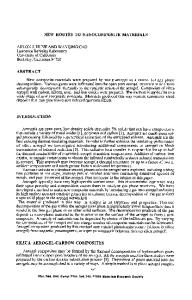New Routes to Silicic Acid Containing Inorganic-Organic Hybrid Precursors and Polymers
- PDF / 710,500 Bytes
- 12 Pages / 414.72 x 648 pts Page_size
- 2 Downloads / 292 Views
Abstract In view of the outstanding role that silicic acids (s~a.) play in inorganic materials a survey will be presented regarding the possibilities of the integration of s.a. in organic matrices via chemical reactions. The objective is to combine the advantageous properties of the silicic acid with those of the organic compounds in order to generate novel m•aterials. The reactions of silicic acids with organic molecules, as studied by 29Si NMR spectroscopy, are described using the silicic acid H8 Si 8 0 20 with a defined double four-ring structure as an example. By silylation of the hydrophilic H8Si80 20 its functional organophilic derivatives were synthesized. The s.a. derivatives with epoxy-, alkoxy-, HSi-, ketoester or unsaturated groups are capable of condensation, polymerization, complexation or additive reactions leading to reactive inorganicorganic precursors or polymers with the defined silicic acid unit. The synthesis and structure of the following s.a. containing precursors and polymers will be reported: (a) inorganic-organic polymers with a high content of silanol groups, (b) microporous polymers free of silanol groups and (c) metal (Al, Zr) alkoxide complexes attached to defined silicic acid units. The model reactions of the double four-ring silicic acid derivatives can be transferred to technical silicic acid solutions prepared from water glass. The presented reaction pathways are a basis for the preparation of a great variety of new inorganic-organic compounds with tailor-made structures and properties which can be used for highly homogeneous and stoichiometric materials.
Introduction
One of the objectives in the development of new materials is the combination of advantageous properties of inorganic and organic compounds into a single material in order to achieve outstanding properties. As an inorganic component in such hybrid materials silica or silicic acids play an important role due to their high reactivity and the great variety of structural types available to produce inorganic polymers [1]. The outstanding properties of inorganic silicate materials are well known from materials such as glasses, ceramics, cements, silica sols, water glass or zeolites. The improvement of the properties of organic materials by silicate fillers such as silica fibers, silica powders or mica has been known for a long time [2]. In these materials the adherence between the inorganic reinforcement and the organic matrix is poor due to insufficient chemical bonding. This work will be concerned solely with hybrid materials with strong chemical bonding. An intensive chemical interaction between silicic acid or silicates and organic compounds has been observed in organic silica sols [I] and organically modified silicates [3, 4]. A strong interaction of hydrolyzable silicic acid esters with functional organic compounds takes place in the sol-gel process, a preferred method for preparation of silicic acid containing 863 Mat. Res. Soc. Syrup. Proc. Vol. 346. 01994 Materials Research Society
inorganic-organic hybrid materi
Data Loading...










